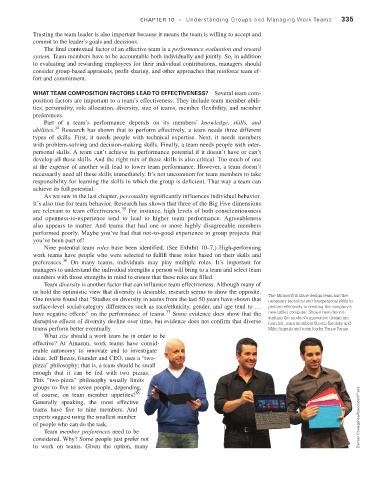Page 336 - Fundamentals of Management Myths Debunked (2017)_Flat
P. 336
CHAPTER 10 • Understanding Groups and Managing Work Teams 335
Trusting the team leader is also important because it means the team is willing to accept and
commit to the leader’s goals and decisions.
The final contextual factor of an effective team is a performance evaluation and reward
system. Team members have to be accountable both individually and jointly. So, in addition
to evaluating and rewarding employees for their individual contributions, managers should
consider group-based appraisals, profit-sharing, and other approaches that reinforce team ef-
fort and commitment.
WhaT TeaM CoMpoSiTion FaCTorS Lead To eFFeCTiveneSS? Several team com-
position factors are important to a team’s effectiveness. They include team member abili-
ties, personality, role allocation, diversity, size of teams, member flexibility, and member
preferences.
Part of a team’s performance depends on its members’ knowledge, skills, and
34
abilities. Research has shown that to perform effectively, a team needs three different
types of skills. First, it needs people with technical expertise. Next, it needs members
with problem-solving and decision-making skills. Finally, a team needs people with inter-
personal skills. A team can’t achieve its performance potential if it doesn’t have or can’t
develop all these skills. And the right mix of these skills is also critical. Too much of one
at the expense of another will lead to lower team performance. However, a team doesn’t
necessarily need all these skills immediately. It’s not uncommon for team members to take
responsibility for learning the skills in which the group is deficient. That way a team can
achieve its full potential.
As we saw in the last chapter, personality significantly influences individual behavior.
It’s also true for team behavior. Research has shown that three of the Big Five dimensions
35
are relevant to team effectiveness. For instance, high levels of both conscientiousness
and openness-to-experience tend to lead to higher team performance. Agreeableness
also appears to matter. And teams that had one or more highly disagreeable members
performed poorly. Maybe you’ve had that not-so-good experience in group projects that
you’ve been part of!
Nine potential team roles have been identified. (See Exhibit 10–7.) High-performing
work teams have people who were selected to fulfill these roles based on their skills and
36
preferences. On many teams, individuals may play multiple roles. It’s important for
managers to understand the individual strengths a person will bring to a team and select team
members with those strengths in mind to ensure that these roles are filled.
Team diversity is another factor that can influence team effectiveness. Although many of
us hold the optimistic view that diversity is desirable, research seems to show the opposite.
One review found that “Studies on diversity in teams from the last 50 years have shown that The Microsoft Surface design team had the
necessary technical and interpersonal skills to
surface-level social-category differences such as race/ethnicity, gender, and age tend to … perform effectively in creating the company’s
37
have negative effects” on the performance of teams. Some evidence does show that the new tablet computer. Shown here demon-
disruptive effects of diversity decline over time, but evidence does not confirm that diverse strating the product’s innovative design are,
from left, team members Steven Sinofsky and
teams perform better eventually. Mike Angiulo and team leader Panos Panay.
What size should a work team be in order to be
effective? At Amazon, work teams have consid-
erable autonomy to innovate and to investigate
ideas. Jeff Bezos, founder and CEO, uses a “two-
pizza” philosophy; that is, a team should be small
enough that it can be fed with two pizzas.
This “two-pizza” philosophy usually limits
groups to five to seven people, depending,
38
of course, on team member appetites!
Generally speaking, the most effective
teams have five to nine members. And
experts suggest using the smallest number Damian Dovarganes/Associated Press
of people who can do the task.
Team member preferences need to be
considered. Why? Some people just prefer not
to work on teams. Given the option, many

